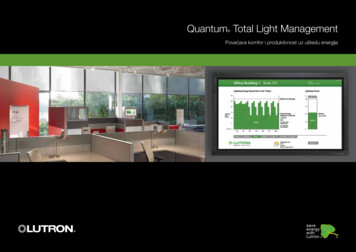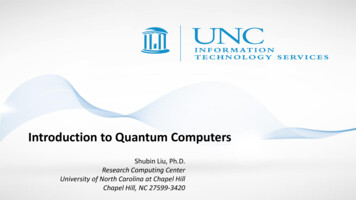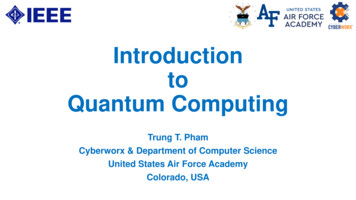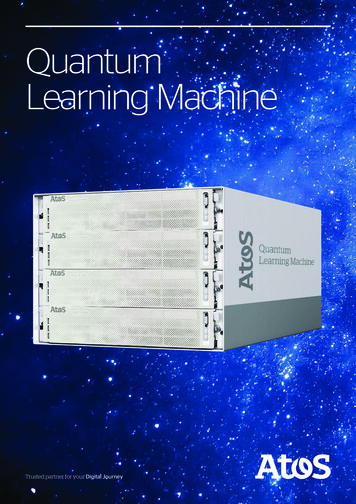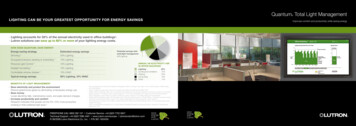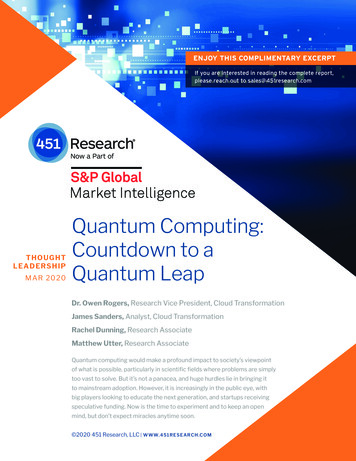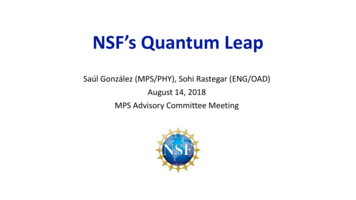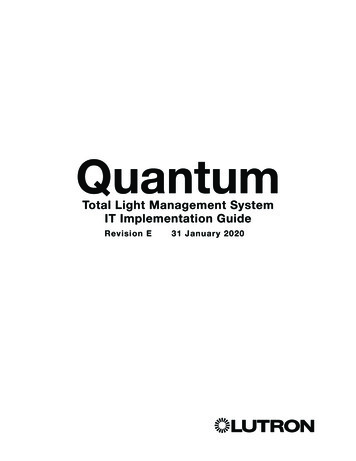
Transcription
QuantumTotal Light Management SystemIT Implementation GuideRevision E31 January 2020
Lutron Quantum Total Light Management System IT Implementation GuideTable of ContentsLutron Quantum Security Statement. . . . . . . . . . . . . . . . . . . . . . . . .3Glossary and Abbreviations. . . . . . . . . . . . . . . . . . . . . . . . . . . . . .4Network and IT ConsiderationsNetwork Architecture Overview. . . . . . . . . . . . . . . . . . . . . . . . . . . . . .5.Manufacturer Hardware . . . . . . . . . . . . . . . . . . . . . . . . . . . . . . . . . 5Physical Medium. . . . . . . . . . . . . . . . . . . . . . . . . . . . . . . . . . . . .5IPv4 Addressing . . . . . . . . . . . . . . . . . . . . . . . . . . . . . . . . . . . . .5Class D Addressing . . . . . . . . . . . . . . . . . . . . . . . . . . . . . . . . . . . 5Ports Required. . . . . . . . . . . . . . . . . . . . . . . . . . . . . . . . . . . . . .6Ports Optional . . . . . . . . . . . . . . . . . . . . . . . . . . . . . . . . . . . . . .7Hop Limit for Unmanaged Networks. . . . . . . . . . . . . . . . . . . . . . . . . . .7Latency Requirements for Managed Networks. . . . . . . . . . . . . . . . . . . . . .7Other Protocols Supported. . . . . . . . . . . . . . . . . . . . . . . . . . . . . . . .7Communication Speed & Bandwidth. . . . . . . . . . . . . . . . . . . . . . . . . . .8Wi-Fi. . . . . . . . . . . . . . . . . . . . . . . . . . . . . . . . . . . . . . . . . . .8Server and Application ConsiderationsMicrosoftR SQL & OS Required for Each Quantum Version. . . . . . . . . . . . . . . .9Hardware Requirements . . . . . . . . . . . . . . . . . . . . . . . . . . . . . . . . 10Software Required. . . . . . . . . . . . . . . . . . . . . . . . . . . . . . . . . . . 12Non-dependent System Server . . . . . . . . . . . . . . . . . . . . . . . . . . . . 12SQL Server Database Usage. . . . . . . . . . . . . . . . . . . . . . . . . . . . . . 12SQL Instance Requirements . . . . . . . . . . . . . . . . . . . . . . . . . . . . . . 12SQL Access . . . . . . . . . . . . . . . . . . . . . . . . . . . . . . . . . . . . . . 13WindowsR Services. . . . . . . . . . . . . . . . . . . . . . . . . . . . . . . . . . . 13Database Size . . . . . . . . . . . . . . . . . . . . . . . . . . . . . . . . . . . . . 13Active Directory . . . . . . . . . . . . . . . . . . . . . . . . . . . . . . . . . . . . 14IIS . . . . . . . . . . . . . . . . . . . . . . . . . . . . . . . . . . . . . . . . . . . 14DNS Host Names . . . . . . . . . . . . . . . . . . . . . . . . . . . . . . . . . . . 14Multi-Instance Installation. . . . . . . . . . . . . . . . . . . . . . . . . . . . . . . . 14Software Installation. . . . . . . . . . . . . . . . . . . . . . . . . . . . . . . . . . 14IIS Features . . . . . . . . . . . . . . . . . . . . . . . . . . . . . . . . . . . . . . 15Browser UI (Quantum Vue). . . . . . . . . . . . . . . . . . . . . . . . . . . . . . . 17Q-Control for iPad . . . . . . . . . . . . . . . . . . . . . . . . . . . . . . . . . . 17Software Maintenance . . . . . . . . . . . . . . . . . . . . . . . . . . . . . . . . . 18Typical System Network Diagram. . . . . . . . . . . . . . . . . . . . . . . . . . 19Communication Port Diagram . . . . . . . . . . . . . . . . . . . . . . . . . . . 202
Lutron Quantum Total Light Management System IT Implementation GuideLutron Quantum Security StatementLutron takes the security of our Lighting Control Systems very seriously. The Quantum LightingControl System can be configured to meet reasonable standards for security. Lutron has engagedsecurity experts and independent testing firms to review the systems architectures and Lutron iscommitted to security and continuous improvement throughout the product lifecycles.Lutron’s Security Architecture Includes:1. Isolation of the wired Ethernet processor network, the wired QS device links, and the wireless ClearConnect device from each other, which strictly limits the possibility of using the Lutron device linksor wireless communication to gain access to the Ethernet network.2. A web browser user interface protected using TLS and capable of accepting acustomer-supplied certificate.3. Vue user account password storage using NIST-recommended salt and hashing protection.Integration with LDAP is optional.4. Authenticated firmware upgrades, such that processors only accept firmware validated and signedby Lutron.System Network DeploymentThe Quantum processors must be connected via Ethernet to allow the processors to communicatewith each other, to access certain features such as BACnetR for BMS integration and tocommunicate with the optional system server. Lutron advises following best practices in thisinstance, including separating the business information network and the building infrastructurenetwork. Use of a VLAN or physically separated networks is recommended for secure deployment.Lutron Services Company Engineers or Lutron Certified Installers can aid in the design andimplementation of the Quantum system to meet your specific IT security needs.The devices on the network can be deployed in one of two ways:Dedicated Lutron Network DeploymentIn this deployment, the Quantum processors are not connected to the building IT network.Dedicated Ethernet cables and switches are used to interconnect the processors with thesystem server.Integrated as Part of the Managed IT NetworkThe Quantum processors communicate with each other, with the system server and with otherbuilding management systems via the building IT network. Integration with other buildingmanagement systems may require ports to be opened between the systems VLANs. It is stronglyrecommended that local IT security professionals be involved with the system design and thenetwork configuration to ensure the installation meets their security needs. A Lutron representativeis available to meet with the security team and IT team to discuss their particular security strategy,networking configuration, VLANs, firewalls, network settings, third-party integration, etc., and torecommend Lutron best practices for a secure deployment of the system.3
Lutron Quantum Total Light Management System IT Implementation GuideGlossary and AbbreviationsHop – Lutron extends the network definition of a hop that traditionally refers to the number ofintermediate devices through which data packets must pass between source and destination toinclude layer 3 and layer 2 devices. This includes any device that will delay the data packets froma source processor to a destination processor. Note: This rule is only applicable when using anunmanaged network to interconnect the devices of a Quantum system.Hop Limit – A hop is one portion of the path that a packet takes from source to destination.Traditionally, the hop limit refers to the time to live (TTL) of that packet before it is discarded. Witha Lutron Quantum system, the hop limit is not concerned with TTL. Rather it is a guideline so thatlatency of Quantum system commands is kept to a minimum. Note: This rule is only applicablewhen using an unmanaged network to interconnect the devices of a Quantum system.Q-Admin – Thick Client UI for setup, monitor and control of the Quantum system. Primary softwarefor all Quantum software versions from 1.5 through 2.7. Primarily used for setup in Quantumsoftware version 3.0 and 3.1. This application is obsolete in Quantum version 3.2 and later.Q-Control App – For limited monitor and control of the Quantum system via an iPad. Refer topage 17 for information on Quantum version availability. Note that Q-Control requires a separateserver per system. Multiple systems cannot be installed on the same server when Q-Control is required.Quantum Hub – Metal enclosure containing the Quantum processor(s). Wall-mounted vertically,predominantly in electrical closets. The QP3 is a smaller enclosure to house a single Quantumprocessor and the QP2 is a larger enclosure to house one or two Quantum processors. The QP2also houses a 5 port unmanaged layer 2 network switch for connectivity.Quantum Processor – This is the basic Quantum controller supporting an expandedMicroC/OS operating system and will be the main Quantum component connected to anynetwork. Each Quantum processor has two RJ45 female connectors, one for the QuantumLAN/VLAN connection and the other for serviceability.Quantum Subsystem – A group of Quantum processors that share events, overrides, BACnetand Telnet integration, sensor controls, or any other system functionality, (normally relegated to asingle floor). The inter-processor communication is UDP multicast. A Quantum subsystem is also amulticast group and shares the same Class D multicast address.Quantum Vue – Browser based UI for setup, monitor and control of the Quantum system. Availableon Quantum software version 3.0 and higher.4
Lutron Quantum Total Light Management System IT Implementation GuideNetwork and IT ConsiderationsNetwork Architecture OverviewWhat is on the traditional network IP architecture? – The Quantum processors, Quantum server,and client devices (e.g. PC, laptop, tablet, etc).What is NOT on the traditional network IP architecture? – The lighting actuators, sensors, andload controllers are not on the network architecture. This includes keypads, wired and wirelessdaylight sensors, wired and wireless occupancy sensors, load controllers, dimmers, switches,lighting panels, fluorescent lamp ballasts, or LED drivers. These devices communicate on a Lutronproprietary wired or wireless communication network.Note that AV integration with the processor can be achieved in 1 of 2 ways:Option 1 – Telnet integration over Ethernet directly to the processor.Option 2 – Using a Lutron model QSE-CI-NWK-E AV integration interface which allows an AVsystem to integrate via RS232 or via a telnet connection over Ethernet that is separatedfrom the processor network.Physical MediumIEEE 802.3 Ethernet – Is the physical medium standard for the network between Quantumprocessors and the Quantum server. Each Quantum processor has 2 female RJ45 connectors.One port is used to connect the processor to the network. The other port is for diagnostics andtroubleshooting by a Lutron service technician. The ports are interchangeable.CAT5e – The minimum network wire specification of the Quantum LAN/VLAN.IP AddressingIPv4 – The addressing scheme used for the Quantum system. The IPv4 address should be staticbut a DHCP reservation system can also be used. Standard DHCP lease is not allowed. DNSHostname is not supported. The IPv4 address can be field set to any range, Class A, B, or C.Static will be assumed. IPv6 is not supported.Class D addressingQuantum Subsystem – A Quantum subsystem is a multicast group of Quantum processorssharing a unique and common class D address that need to share events. Maximum 16 Quantumprocessors on a Quantum subsystem. Minimum one Quantum processor on aQuantum subsystem.Multicast communications – Basic communication to share events between Quantum processorsand the Quantum server is based on UDP multicast groups. Below are details on how theQuantum system deploys this communication scheme. Each group of Quantum processors that need to share events will need a unique and commonclass D address. The class D multicast address can be field set and specified by the customer.Processors needing to share events are normally limited to a single floor. Any source multicast is used because any Quantum processor may be enacting the event. Multicast communication in the Quantum system is primarily event based (e.g. system trigger orchange in state for monitoring). Polling is not a basis of communications in Quantum. Prior to software version 3.0, the Quantum server needed to join every multicast group tocommunicate to the Quantum processors. Quantum servers hosting software version 3.0 andnewer can either communicate to the Quantum processors by joining every multicast group orcan be setup as TCP unicast communication. This can be setup during system startup at thecustomer’s discretion. Note: Multicast communication is still required for communication among the processors in asubsystem. The only way to completely eliminate all multicast from a Quantum system is todesign the system so that there is only one processor in each subsystem.5
Lutron Quantum Total Light Management System IT Implementation GuideNetwork and IT Considerations(continued)Ports (REQUIRED)Quantum processor to Quantum processors within a Quantum subsystemUDP/2055 up to 2184 (1 per subsystem).Quantum Application Server to Quantum processors UNICAST OPTIONTCP/51023 TCP available only for Quantum servers hosting software version 3.0 and newerQuantum Application Server to Quantum processors MULTICAST OPTIONUDP/2055 up to 2184 (1 per subsystem).Note: U nicast or multicast communication option is configured on site by a Lutron fieldengineer and at the customers determination. System will default to multicast if notspecified.Quantum Vue Web PageSource TCP/49152 - 65535 to Destination TCP/443 (HTTPS) or TCP/80 (HTTP) Available only for Quantum servers hosting software version 3.0 and newer Quantum version 3.0 through 3.3 defaults to port 80 but can be configured for port 443 Quantum version 3.4 and later defaults to port 4436
Lutron Quantum Total Light Management System IT Implementation GuideNetwork and IT Considerations(continued)Ports (OPTIONAL)Quantum Processor Configuration and detection softwareUDP/2647 Only required while performing initial commissioning or maintenanceQuantum Processor BACnet/IPUDP/47808 Only required if the Quantum system is integrating with a BMS through BACnet/IP UDP Port 47808 may be CHANGED at the customer’s discretion at any time duringsystem startup by a field service engineer.Q-Control App to Quantum Application ServerSource TCP/5443 and TCP/5327 Only required if the Quantum system is specified to use the Lutron Q-Control AppQuantum Processor TELNETSource TCP/23 (default) Only required if the Quantum system is integrating with AV equipment through Serial/IP This port is open by default in versions 3.3. and earlier This port is closed by default in Quantum version 3.4 and later and will only be open iftelnet integration is required The port number is also configurable if desiredQuantum Processor Additional PortsSource TCP21 (FTP) and TCP80 (HTTP) These ports are open by default in versions 3.3. and earlier These ports are closed in Quantum version 3.4 and laterHop Limit for Unmanaged NetworksThe required hop limit of any data packet from a source processor to a destination processor/server within a single subsystem is 6. Note: This rule is only applicable when using an unmanagednetwork to interconnect the devices of a Quantum system and is required to ensureoptimal performance.Latency Requirements for Managed NetworksNote that for managed networks, the maximum latency between any 2 Quantum processorsshould be less than 10 ms. The maximum latency between the Quantum server and any processoris 10 ms.Other Protocols SupportedIGMP – Quantum supports Versions 1, 2, and 3 for multicast communication within a subsystem.Any possible flooding of multicast traffic can be constrained to a set of interested ports by usingIGMP snooping.PIM – If Quantum processors within a subsystem are deployed on different subnets and needrouting, PIM is supported in both sparse and dense modes. PIM is typically not required if theconnections from the server to the processors is configured for Unicast.7
Lutron Quantum Total Light Management System IT Implementation GuideNetwork and IT Considerations(continued)Other Protocols Supported (continued)BACnet/IP – BACnet is a communications protocol for building automation and controlnetworks. It is defined in ASHRAE/ANSI standard 135. Below are details on how the Quantumsystem implements BACnet communications. BACnet communication is used to allow two-way communication between the Quantumsystem and a Building Management System (BMS) for control and monitoring of the system. The Quantum processors adhere to Annex J of the BACnet standard. Annex J defines BACnet/IP which uses BACnet communication over a TCP/IP network. The BMS communicates directly to the Quantum processors, not to theQuantum server. If the BMS is on a different subnet than the Quantum processors thenBACnet/IP Broadcast Management Devices (BBMDs) can be used to allow the BMS tocommunicate across subnets.Telnet – Telnet is an application layer protocol used to provide a bi-directional text-basedcommunication between client and server devices. The Quantum processors will use thisprotocol over TCP/IP for two main instances:1. Telnet may be used during system startup to run diagnostics and initiate firmware updates.Once system startup is complete, the Telnet port may be closed.2. If there is an AV system (e.g. a touchscreen) integrating with the Quantum system, it maycommunicate to the Quantum processor over a Telnet session. By default, port 23 will be usedbut this can be changed at the customer’s discretion. Alternatively, a Lutron QSE-CI-NWK-Ecan be added to the system for AV integration. This device provides either an RS232 ortelnet over Ethernet point of integration that is not required to be on the same network as theQuantum processors. For limitations, see the QSE-CI-NWK-E specification submittal(P/N 369373) at www.lutron.com.Communication Speed and Bandwidth100 BaseT – Is the maximum communication speed required for the Quantum processor andQuantum server communications.1.88 MBPS – Worst case bandwidth in a fully loaded subsystem of 16 processors. Mostsubsystems include only 1 to 4 processors.Wi-FiThe Optional Q-Control app for iPad requires IEEE 802.11 wireless communication so thatthe iPad can communicate with the server. Quantum Vue, which is a web page hosted on theQuantum server in IIS can also be available over the wireless network if desired.8
Lutron Quantum Total Light Management System IT Implementation GuideServer and Application ConsiderationsMicrosoftR SQL & OS Required for Each Quantum VersionSoftware VersionMicrosoft SQL VersionMicrosoft OS VersionQuantum 1.5 - 1.9SQL 2005 Express (default)SQL 2005 Full* (requires custom installation)Quantum 2.0 - 2.7SQL 2005 Express (default)SQL 2005 Full* (requires custom installation)Quantum 3.0 - 3.1SQL 2012 Express (default)SQL 2012 Full* (requires custom installation)Quantum 3.2SQL 2012 Express (default)SQL 2012 Full* (requires custom installation)Quantum 3.4SQL 2017 Express (default)SQL 2017 Full* (requires custom installation)Windows XP Pro (32-bit)Windows 2003 Server (32-bit)Windows XP Pro (32-bit)Windows 7 Professional (32 or 64-bit)Windows 2003 Server (32-bit)Windows 2008 R2 Server (64-bit)Windows 7 Professional (64-bit)Windows 8 Professional (64-bit)Windows 8.1 Professional (64-bit)Windows 10 Professional (64-bit)Windows 10 Enterprise (64-bit)Windows 2008 R2 Server (64-bit)Windows 2012 R1 Server (64-bit)Windows 2012 R2 Server (64-bit)Windows 7 Professional (64-bit)Windows 2008 R2 Server (64-bit)Windows 8 Professional (64-bit)Windows 8.1 Professional (64-bit)Windows 10 Professional (64-bit)Windows 10 Enterprise (64-bit)Windows 2012 R1 Server (64-bit)Windows 2012 R2 Server (64-bit)Windows 2016 Server (64-bit)Windows 10 Professional (64-bit)Windows 2012 R1 Server (64-bit)Windows 2012 R2 Server (64-bit)Windows 2016 Server (64-bit)Windows 2019 Server (64-bit)* C onfiguring the Quantum system to use a full install of SQL server will require additional fieldservice time as well as customer IT/DBA support. The SQL instance must be installed on theapplication server where the Quantum software is installed. Remote SQL is not supported.9
Lutron Quantum Total Light Management System IT Implementation GuideServer and Application Considerations (continued)Hardware RequirementsQuantumVersionLaptop or DesktopPhysical ServerVirtual Server1.5-1.9 IntelR Core i3 processor Integrated IntelR HD Graphicsor 256 MB dedicatedgraphics card 1 GB RAM 50 GB hard drive Screen with minimum 1024 x768 resolution 10/100 MB wired Ethernetnetwork interface IntelR XeonR processor Dedicated graphics card with256 MB memory 2 GB RAM 80 GB hard drive Screen with minimum 1024 x768 resolution Two (2) 10/100 MB wiredEthernet network interfaces One for communication to theQuantum processors One for communication toother computers on thecorporate network Only needed if processorsare not on the corporatenetwork IntelR XeonR processor 2 GB RAM 80 GB hard drive Two (2) 10/100 MB wiredEthernet network interfaces One for communication tothe Quantum processors One for communication toother computers on thecorporate network May be warranted ifQuantum subsystemnetwork is notaccessible througha firewall from thecorporate backbone2.0-2.7 IntelR Core i3 processor Integrated IntelR HD Graphicsor 256 MB dedicatedgraphics card 2 GB RAM 100 GB hard drive Screen with minimum 1024 x768 resolution 10/100 MB wired Ethernetnetwork interface Dual Core IntelR XeonR processor Dedicated graphics card with256 MB memory 4 GB RAM 100 GB hard drive Screen with minimum 1024 x768 resolution Two (2) 10/100 MB wiredEthernet network interfaces One for communication to theQuantum processors One for communication toother computers on thecorporate network Only needed if processorsare not on the corporatenetwork Dual Core IntelR XeonRprocessor 4 GB RAM 100 GB hard drive Two (2) 10/100 MB wiredEthernet network interfaces One for communication tothe Quantum processors One for communication toother computers on thecorporate network Only needed ifprocessors are not onthe corporate network10
Lutron Quantum Total Light Management System IT Implementation GuideServer and Application Considerations(continued)Hardware Requirements (continued)QuantumVersionLaptop or DesktopPhysical ServerVirtual Server3.0-3.3 IntelR Core i3 processor Integrated IntelR HD Graphicsor 256 MB dedicatedgraphics card 4 GB RAM 250 GB hard drive Screen with minimum 1280 x1024 resolution 10/100 MB wired Ethernetnetwork interface Quad Core IntelR XeonRprocessor Dedicated graphics card with256 MB memory 8 GB RAM 250 GB hard drive Screen with minimum 1280 x1024 resolution Two (2) 10/100 MB wiredEthernet network interfaces One for communication to theQuantum processors One for communication toother computers on thecorporate network Only needed if processorsare not on the corporatenetwork Quad Core IntelR XeonRprocessor 8 GB RAM 250 GB hard drive Two (2) 10/100 MB wiredEthernet network interfaces One for communication tothe Quantum processors One for communication toother computers on thecorporate network May be warranted ifQuantum subsystemnetwork is not accessiblethrough a firewall fromthe corporate backbone3.4 Intel CoreR i7 (4 cores,8 threads 2.5 GHz) or AMDequivalent 16 GB RAM 500 GB SSD hard drive Screen with minimum 1280 x1024 resolution Minimum 100 MB wiredEthernet network interface IntelR XeonR (4 cores, 8 threads2.5 GHz) or AMD equivalent 16 GB RAM 500 GB SSD hard drive Screen with minimum 1280 x1024 resolution Minimum 100 MB wired Ethernetnetwork interface IntelR XeonR (4 cores, 8 threads2.5 GHz) or AMD equivalentwith Multi-threading 8T enabled 16 GB RAM 500 GB SSD hard drive Minimum 100 MB wiredEthernet network interface11
Lutron Quantum Total Light Management System IT Implementation GuideServer and Application Considerations(continued)Software Required MicrosoftR Internet Information Services (IIS) 7 or later for Quantum Vue MicrosoftR .NET Framework 3.5 MicrosoftR .NET Framework 4.5 (Quantum 3.0 and 3.1) MicrosoftR .NET Framework 4.6.1 (Quantum 3.2 and later) A web browser that supports HTML-5, the latest version of GoogleR ChromeR recommendedNon-Dependent System ServerThe Quantum processors can fully function without server connectivity. Loss of serverconnectivity does not affect timeclock events, lighting overrides, BACnet or telnet integration,sensor control, or any other daily functionality. The Quantum server services two functions;1. Enables End User UI – Provides the web server for Quantum 3.x and higher, provides theserver for the thick client UI, provides the app server for the Q-Control App for adjustmentsand monitoring of the Quantum system.2. Historical Data Collection – All energy management and asset management is stored on theSQL logging server for reporting.SQL Server Database UsageApplication (Runtime Project) Database – Stores all of the configuration information for thesystem (areas, zones, programming, and other settings). A locally installed instance of SQLServer Express edition is best suited for this database and is automatically installed andconfigured during installation of Quantum on the server. Due to the operations performed(backup, restore, etc.) the Quantum software requires high-level permissions to this database.For this reason, remote SQL is not supported in the Quantum system.Logging Database – Real-time database that stores system and user activity reported from theQuantum system. Used to generate historical activity reports in Q-Admin and Quantum Vuesoftware.Energy Database – Real-time database that stores energy consumption data for the lightingcontrol system. Used to show energy reports in Quantum Vue. Data is recorded at an area levelevery time there is a change in the system.SQL Instance Requirements Lutron requires a dedicated SQL instance for all installs for data integrity and reliability. A Quantum system does not support remote SQL. The SQL instance must be installed on theapplication server. System administrator privileges are required for Quantum software to access the SQL instance. MicrosoftR SQL Server Express will be installed by default. Alternatively, full SQL can be installedif provided by the customer.12
Lutron Quantum Total Light Management System IT Implementation GuideServer and Application Considerations(continued)SQL AccessLutron applications use “sa” user and “sysadmin” permission levels with SQL Server becausethe Quantum applications need backup, restore, create new, delete and modify permissionsunder normal use. The username and password can be changed but the privileges arerequired. Note that only SQL authentication is supported.WindowsR ServicesThe Lutron Services Manager is a WindowsR service that runs on the Quantum server andprovides status information about key Quantum applications and also ensures that theyare running any time the machine is restarted. The Lutron Services Manager applicationcoincides with the Lutron Service Manager service which should always be running on theserver machine. It can be accessed using the small red “gears” icon in the system tray or fromServices within the WindowsR operating system.Quantum applications in Lutron Service Manager includes: Q-Runtime – runs in the background and serves a number of purposes, among them it acts asa facilitator of system traffic. Q-Reporting – stores system data and logs it for the purpose of displaying energy savings,system events, or user activity. Q-Gateway – interfaces the Q-Control App and Quantum Vue with the Quantum server. Q-Alerts – monitors the system for certain events/triggers and raise awareness through visiblechanges in the Quantum software or through email messages.Alerts can be emailed using SMTP server connection and port designation. SSL encryption andauthentication can also be enabled.Database SizeTypically, each database is capped at 10 GB when using SQL Server 2017 Express edition.If this database is deployed to a customer-supplied instance of SQL Server full edition on theapplication server, the 10 GB limit need not apply and the policy for data retention can bespecified using Quantum configuration options.Application (Runtime Project) Database – Does not grow appreciably post-deployment. Datamodifications take place via software tools like Q-Admin and Quantum Vue where a facilitymanager can modify scheduled events and settings. Typical size is less than 100 MB but canreach 250 MB for very large buildings or campuses.Logging Database – Growth of the database varies based on the size of the facility, nature ofdevices used, and occupant activity. For example, occupancy sensors and daylight sensorstend to report larger volumes of data as compared to other devices. High occupancy facilitieswill see greater numbers of occupancy related events, etc. When using SQL Server 2017Express edition, the database can store a minimum of 3 months of activity data. The databasewill delete the oldest information once it is close to being full.Energy Database – When using SQL Server 2017 Express edition, the database can store up to10 years of energy data for systems having 2,000 areas or less (rooms).13
Lutron Quantum Total Light Management System IT Imple
Lutron Quantum Total Light Management System IT Implementation Guide 4 Glossary and Abbreviations Hop - Lutron extends the network definition of a hop that traditionally refers to the number of intermediate devices through which data packets must pass between source and destination to

